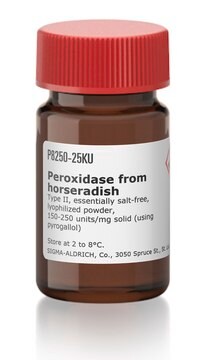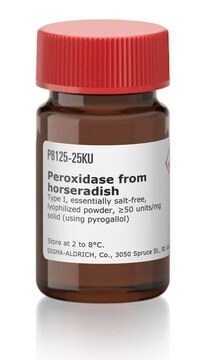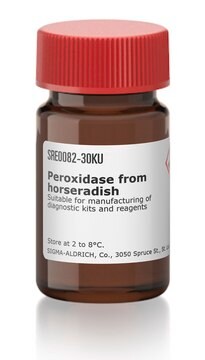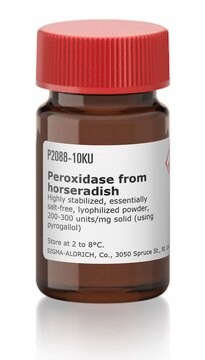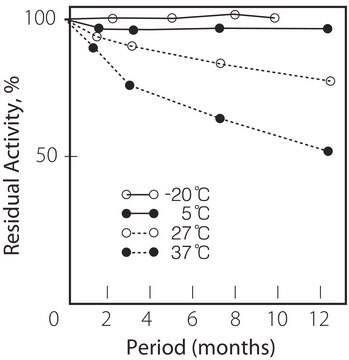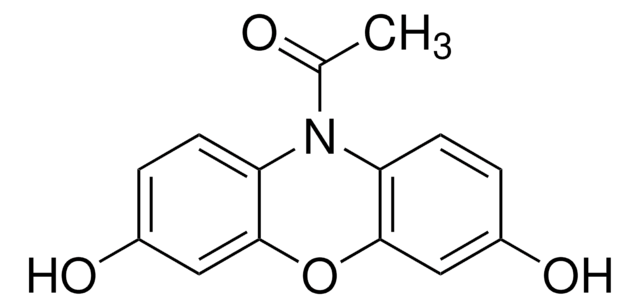General description
Horseradish peroxidase is isolated from horseradish roots (Amoracia rusticana) and belongs to the ferroprotoporphyrin group of peroxidases. HRP is a single chain polypeptide containing four disulfide bridges. It is a glycoprotein containing 18% carbohydrate. The carbohydrate composition consists of galactose, arabinose, xylose, fucose, mannose, mannosamine, and galactosamine depending upon the specific isozyme. Its molecular weight (~44 kDa) includes the polypeptide chain (33,890 Daltons), hemin plus Ca2+ (~700 Daltons), and carbohydrate (~9,400 Daltons). At least seven isozymes of HRP exist. The isoelectric point for horseradish peroxidase isozymes ranges from 3.0 - 9.0.
Application
Horseradish peroxidase (HRP) is isolated from horseradish roots (Amoracia rusticana) and belongs to the ferroprotoporphyrin group of peroxidases.. It is used in biochemistry applications such as western blots, ELISA and Immunohistochemistry. Horseradish peroxidase is used to amplify a weak signal and increase detectability of a target molecule, such as a protein. Product P8375, type VI, is an essentially salt free lyophilized powder. It is commonly used to determine amounts of glucose and peroxides in solution. It has been used to study sensory input of cervical spinal cord neurons.
The enzyme has been used to develop a thermostable soybean peroxidase-based biosensor by cross-linking and electrically ′wiring′ the enzyme through a redox-conducting hydrogel to a glassy carbon electrode. It has also been used to assay the oxidation of low density lipoprotein.
Biochem/physiol Actions
HRP readily combines with hydrogen peroxide (H2O2) and the resultant [HRP-H2O2] complex can oxidize a wide variety of hydrogen donors. The optimal pH is 6.0-6.5 and the enzyme is most stable in the pH range of 5.0-9.0. HRP can be conjugated to antibodies by several different methods including glutaraldehyde, periodate oxidation, through disulfide bonds, and also via amino and thiol directed cross-linkers. It is smaller and more stable than the enzyme labels β-galactosidase and alkaline phosphatase and hence, it is the most desired label. Also, its glycosylation leads to lower non-specific binding.
When incubated with a substrate, horseradish peroxidase produces a coloured, fluorimetric, or luminescent derivative of the labeled molecule, allowing quantification. Horseradish peroxidase has been shown to slightly reduce the level of inhibition in a cydAB mutant. Known inhibitors are sodium azide, cyanide, L-cystine, dichromate, ethylenethiourea, hydroxylamine, sulfide, vanadate, p-aminobenzoic acid, and Cd2+, Co2+, Cu2+, Fe3+, Mn2+, Ni2+, and Pb2+ ions.
Unit Definition
One pyrogallol unit will form 1.0 mg purpurogallin from pyrogallol in 20 sec at pH 6.0 at 20 °C.
Analysis Note
The RZ (Reinheitszahl) is the absorbance ratio A403/A275 determined at 0.5-1.0 mg/ml in deionized water. It is a measure of hemin content, not enzymatic activity. Even preparations with high RZ may have low enzymatic activity.

